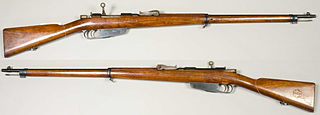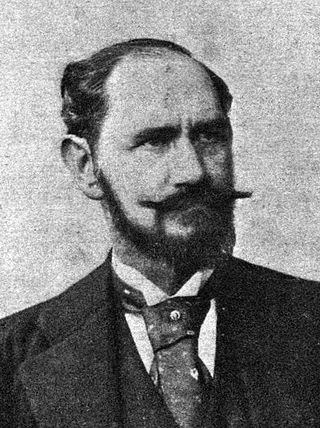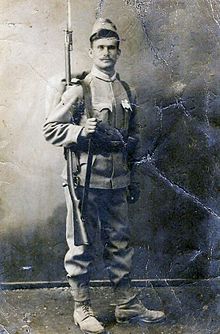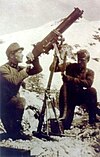
A semi-automatic rifle is an autoloading rifle that fires a single cartridge with each pull of the trigger and uses part of the fired cartridge's energy to eject the case and load another cartridge into the chamber. In contrast, a bolt-action rifle requires the user to cycle the bolt manually before they can fire a second time, and a fully automatic rifle fires continuously until the trigger is released.

The Lebel Model 1886 rifle also known as the "Fusil Mle 1886 M93", after a bolt modification was added in 1893, is an 8 mm bolt-action infantry rifle that entered service in the French Army in 1887. It is a repeating rifle that can hold eight rounds in its fore-stock tube magazine, one round in the elevator plus one round in the chamber; equaling a total of ten rounds held. The Lebel rifle has the distinction of being the first military firearm to use smokeless powder ammunition. The new propellant powder, "Poudre B," was nitrocellulose-based and had been invented in 1884 by French chemist Paul Vieille. Lieutenant Colonel Nicolas Lebel contributed a flat nosed 8 mm full metal jacket bullet. Twelve years later, in 1898, a solid brass pointed (spitzer) and boat-tail bullet called "Balle D" was retained for all 8mm Lebel ammunition. Each case was protected against accidental percussion inside the tube magazine by a primer cover and by a circular groove around the primer cup which caught the tip of the following pointed bullet. Featuring an oversized bolt with front locking lugs and a massive receiver, the Lebel rifle was a durable design capable of long range performance. In spite of early obsolete features, such as its tube magazine and the shape of 8mm Lebel rimmed ammunition, the Lebel rifle remained the basic weapon of French infantry during World War I (1914–1918). Altogether, 3.45 million Lebel rifles were produced by the three French state factories between 1887 and 1916.

Carcano is the frequently used name for a series of Italian bolt-action, internal box magazine fed, repeating military rifles and carbines. Introduced in 1891, the rifle was chambered for the rimless 6.5×52mm Carcano round. It was developed by the chief technician Salvatore Carcano at the Turin Army Arsenal in 1890, and was originally called the Modello (model) 91 or simply M91. Successively replacing the previous Vetterli-Vitali rifles and carbines in 10.35×47mmR, it was produced from 1891 to 1945. The M91 was used in both rifle (fucile) and shorter-barreled carbine (moschetto) form by most Italian troops during World War I and by Italian and some German forces during World War II. The rifle was also used during the Winter War by Finland, and again by regular and irregular forces in Syria, Libya, Tunisia, and Algeria during various postwar conflicts in those countries.

The Lee–Metford rifle is an obsolete bolt-action British army service rifle, combining James Paris Lee's rear-locking bolt system and detachable magazine with an innovative seven-groove rifled barrel designed by William Ellis Metford. It replaced the Martini–Henry rifle in 1888, following nine years of development and trials, but remained in service for only a short time until replaced by the similar Lee–Enfield.

The 7×57mm Mauser is a first-generation smokeless powder rimless bottlenecked rifle cartridge. It was developed by Paul Mauser of the Mauser company in 1892 and adopted as a military cartridge by Spain in 1893. It was subsequently adopted by several other countries as the standard military cartridge, and although now obsolete as a military cartridge, it remains in widespread international use as a sporting round. The 7×57 Mauser was a popular stalking cartridge and sporting rifles in this chambering were made by the famous British riflemakers, such as John Rigby, Holland and Holland, Westley Richards and others. British cartridge nomenclature designated caliber in inches, and the cartridge was known as the .275 bore after the measurement of a 7 mm rifle's bore across the lands.

The Mannlicher M1895 is a straight pull bolt-action rifle, designed by Ferdinand Ritter von Mannlicher that used a refined version of his revolutionary straight-pull action bolt, much like the Mannlicher M1890 carbine. It was nicknamed the Ruck-Zuck-[Gewehr] by Austrian troops and "Ta-Pum" by Italian troops who wrote a song (it) about it during World War I. The primary producers were the ŒWG in Steyr, and FÉG in Budapest.
The Mannlicher–Schönauer is a rotary-magazine bolt-action rifle produced by Steyr Mannlicher for the Greek Army in 1903 and later used in small numbers by the Austro-Hungarian Army. Post-war it was sold for civilian use.

Ferdinand Ritter von Mannlicher was an Austrian engineer and small arms designer. Along with James Paris Lee, Mannlicher was particularly noted for inventing the en-bloc clip charger-loading box magazine system. Later, while making improvements to other inventors' prototype designs for rotary-feed magazines, Mannlicher, together with his protégé Otto Schönauer, patented a perfected rotary magazine design, the Mannlicher–Schönauer rifle, which was a commercial and military success.

The Gewehr 88 was a late 19th-century German bolt-action rifle, adopted in 1888.

The Mauser Model 1871 adopted as the Gewehr 71 or Infanterie-Gewehr 71, or "Infantry Rifle 71" was the first rifle model in a distinguished line designed and manufactured by Paul Mauser and Wilhelm Mauser of the Mauser company and later mass-produced at Spandau arsenal.

The 8×50mmR Lebel rifle cartridge was the first smokeless powder cartridge to be made and adopted by any country. It was introduced by France in 1886. Formed by necking down the 11×59mmR Gras black powder cartridge, the smokeless 8mm Lebel cartridge started a revolution in military rifle ammunition. Standard 8mm Lebel military ammunition was also the first rifle ammunition to feature a spitzer boat tail bullet, which was adopted in 1898. The long-range ballistic performance of the 8mm Lebel bullet itself was exceptional for its time. For use in the magazine tube-fed early Lebel rifle, the 8 mm case was designed to protect against accidental percussion inside the tube magazine by a circular groove around the primer cup which caught the tip of the following pointed bullet. However, the shape of its rimmed bottle-necked case, having been designed for the Lebel rifle's tube magazine, also precluded truly efficient vertical stacking inside a vertical magazine. The bolt thrust of the 8mm Lebel is relatively high compared to many other service rounds used in the early 20th century. Although it was once revolutionary, the 8mm Lebel was declared obsolete after World War I and was soon after replaced with the 7.5×54mm French round.
The Austro-Hungarian 8×50mmR Mannlicher or 8×50mmR M93 is a service cartridge dating back to the days of semi-smokeless powder. It was later replaced by the 8×56mmR cartridge.

The M1870 Vetterli was the Italian service rifle from 1870 to 1891. In 1887, it would be modified into the repeating M1870/87 Italian Vetterli-Vitali variant. The Vetterli rifle used the 10.4mm Vetterli centrefire cartridge, at first loaded with black powder and later with smokeless powder. Some Vetterli rifles would later be converted into 6.5×52mm Carcano during World War I. Despite being supplanted by the Carcano rifle, it continued to see use in Italian service and abroad.
The Remington–Lee is a bolt-action, detachable box magazine repeating rifle designed principally by James Paris Lee in the mid-1870s.

The Geweer M. 95, also known to collectors as the Dutch Mannlicher, was the service rifle of the armed forces of the Netherlands between 1895 and 1940 which replaced the obsolete Beaumont-Vitali M1871/88. At first it was produced by Steyr for the Dutch, but after 1904, production took place under license at a Dutch state weapon factory in Zaandam known by the name of close by Hembrug bridge. Although often regarded as being based on the earlier Mannlicher 1893 Model, the rifle is in fact a modification of the Mannlicher rifle by August Schriever and the Dutch rifle commission. The Dutch issued about 470,000 M.95s.

The Mauser Model 1889 is a bolt-action rifle of Belgian origin. It became known as the 1889 Belgian Mauser, 1891 Argentine Mauser, and 1890 Turkish Mauser.

The Repeating Carbine Model 1890 a.k.a. Mannlicher Model 1890 Carbine is a bolt-action rifle, designed by Ferdinand Mannlicher that used a new version of his straight-pull action bolt. It was introduced as an alternative to the Mannlicher M1888 as it was shorter and easier to maneuver with. Three main versions were introduced: Cavalry Carbine, Gendarmerie Carbine and Navy Short Rifle.

The Repeating Rifle Model 1886, commonly known as Mannlicher Model 1886, was a late 19th-century Austrian straight-pull bolt-action rifle, adopted in 1886. It used a wedge-lock straight pull action bolt. It was the first straight-pull bolt-action service rifle of any nation.

The Mannlicher M1893 is a bolt-action rifle that was the standard service rifle of the Kingdom of Romania from 1893 to 1938. The rifle and its 1892 predecessor were the first repeating rifles to be widely issued in the Romanian military. It was later replaced by the Czechoslovak-designed Vz. 24 as the standard service rifle.
The 8×52mmR Mannlicher cartridge was first introduced in 1888 for the Mannlicher M1888 rifle, an updated version of the Mannlicher M1886.



















